6000K vs. 5000K : Comprehensive Analysis
Table of Contents
Choosing the right LED lighting involves more than just brightness levels—it also requires an understanding of color temperature, a key factor that influences a space’s look, feel, and functionality. Measured in degrees Kelvin (K), color temperature affects everything from how colors appear to how comfortable or alert we feel in a given environment. Warmer temperatures (2700K–3000K) create a cozy, yellowish glow, while cooler temperatures (5000K–6000K and higher) offer a sharper, more energizing light ideal for productivity and visibility.
This guide focuses on two commonly used LED color temperatures: 5000K and 6000K. Though they are close in value, the difference in appearance and effect can be significant. A 5000K light delivers a neutral white tone, similar to natural daylight, making it perfect for areas where true color accuracy and a clean look are essential—like offices, workshops, and retail spaces. In contrast, 6000K lighting produces a cool, bluish-white light that feels brighter and more intense, often used in security lighting, hospitals, or places requiring high visual precision.
In the this guide, I’ll break down how each option performs in different settings, explain the science behind the Kelvin scale, and guide you through choosing the most appropriate color temperature based on your specific needs. Whether you’re designing a workspace, upgrading your home lighting, or outfitting a commercial property, understanding this comparison will help you make a confident, informed decision.
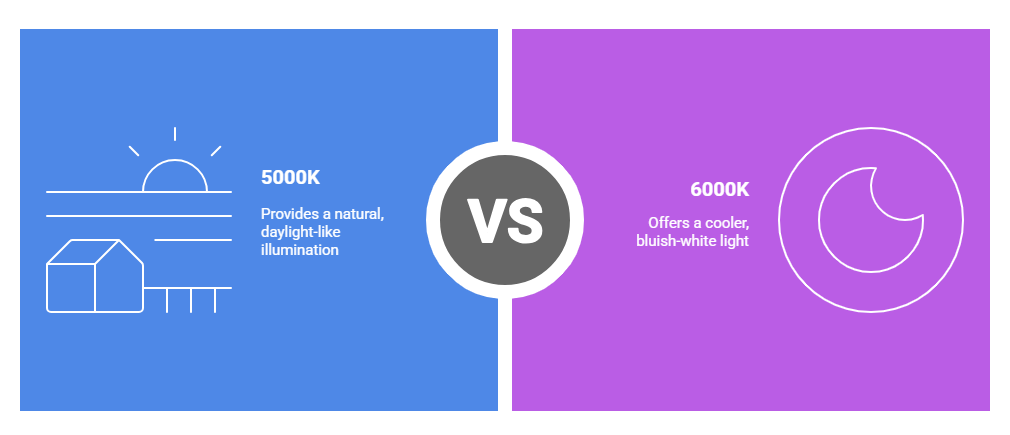
What Is Color Temperature in LED Lighting?
Color temperature refers to the appearance or tone of light emitted by a light source, and it plays a crucial role in both visual aesthetics and functional performance. Measured in degrees Kelvin (K), color temperature is rooted in the concept of blackbody radiation—a principle from physics that describes how an ideal object (called a blackbody) emits light as it heats up. As the blackbody’s temperature rises, the color of the emitted light shifts gradually: from deep red to orange, then to yellow, white, and eventually blue. This progression forms the basis of how we measure and describe color temperature in lighting systems.
The Kelvin scale is an absolute temperature scale used to define the spectrum of light appearance. Lower Kelvin values, typically between 2700K and 3000K, produce a warm, yellowish glow commonly referred to as soft white. This type of light creates a cozy and inviting atmosphere, ideal for residential settings like bedrooms and living rooms. As the Kelvin value increases to around 4000K to 5000K, the light takes on a more neutral and balanced tone, often labeled as cool white or daylight, which is preferred in offices, kitchens, and task-oriented environments. At the higher end of the spectrum—6000K and above—the light appears bluish-white, giving off a crisp and clinical feel, often used in industrial, commercial, or security lighting.

In the context of LED lighting, understanding color temperature is essential for selecting the right fixture for your needs. It not only impacts how a space looks, but also how it functions and how people feel within it. The right color temperature can enhance visual comfort, boost productivity, and influence mood. Whether you’re lighting a home, office, retail space, or warehouse, choosing the appropriate color temperature ensures that your lighting supports the intended atmosphere and purpose of the environment.
What does 5000K LED lighting mean?
5000K LED lighting generates a soft, pure white light slightly milder than 6000K while maintaining brightness and clarity. This colour temperature is often associated with a harmonious and comfortable ambience, making it suitable for various applications.
Key Features of 5000K light
- Pure white illumination: 5000K LED lights emit a neutral, untainted white light that enhances the natural and accurate portrayal of colours.
- Optimal brightness balance: While retaining brightness, 5000K light is gentler than 6000K, providing a more comfortable illumination level for diverse settings.
- Comfortable and adaptable: Due to its neutral tone and balanced brightness, 5000K light is highly versatile and can create a pleasant atmosphere in various environments.
Pros and Cons of 5000K LED Lighting
Pros:
-
Balanced and Natural Light: Provides a neutral white light similar to daylight, offering a clean and natural look, ideal for most indoor spaces.
-
Versatile: Suitable for a wide range of areas, such as kitchens, offices, and living rooms, where clarity and comfort are needed.
-
Enhanced Color Accuracy: Offers better color rendering, making it great for tasks like cooking, reading, and artistic work.
-
Energy Efficient: Like most LED options, 5000K LEDs are energy-efficient and provide good brightness without using excessive power.
-
Reduces Eye Strain: Its balanced brightness is soft enough for most tasks, helping reduce eye strain.
Cons:
-
Not Ideal for Relaxation: Its neutral tone doesn’t create the cozy, warm atmosphere often desired for relaxation spaces like bedrooms or lounges.
-
Can Feel Too Bright: In rooms intended for rest or leisure, 5000K can feel overly bright and sterile.
-
Limited Ambience Use: It’s not the best choice for creating a relaxed, warm, inviting ambiance in spaces like living rooms.
Applications of 5000K LED lighting
- General lighting: 5000K LED lights are an excellent choice for general lighting in residential and commercial spaces. They offer a comfortable level of brightness and faithfully reproduce colours.
- Retail stores: The neutral colour of 5000K lighting aids in the accurate and appealing display of products, enhancing the shopping experience for customers.
- Office spaces: In office environments, 5000K LED lights contribute to a productive, focused atmosphere while minimizing eye strain and fatigue.
- Outdoor areas: 5000K LED lights can be effectively employed in outdoor settings such as parks, gardens, and walkways. They provide a well-balanced and inviting illumination that enhances both safety and aesthetics.
What is 6000K LED lighting?
6000K LED lighting produces a cool white light with a gentle blue undertone, simulating the appearance of natural daylight. This particular colour temperature is often linked to qualities such as clarity, focus, and productivity.
Key Features of 6000K Lighting:
- Bright and high-contrast: The 6000K light source offers a clear and vibrant illumination, facilitating the observation of fine details and facilitating tasks that demand attentiveness to specifics.
- Subtle bluish tint: Emitting a cool white light, 6000K LEDs possess a faint blue hue, which can contribute to a contemporary and pristine visual ambience in diverse environments.
- Improved visibility and concentration: The brightness and colour temperature of 6000K lighting can enhance alertness and concentration, making it highly suitable for spaces where focus and productivity are paramount.
Pros and Cons of 6000K LED Lighting
Pros:
-
Bright and Crisp: Provides a cool, intense light with high contrast, ideal for tasks requiring high visibility, such as workshops or garages.
-
Perfect for Detailed Tasks: Best for spaces that require precision and clarity, such as reading, studying, or fine work.
-
Increases Alertness: Mimics daylight, which can boost productivity and alertness, making it ideal for workspaces or offices.
-
Modern Aesthetic: The bluish-white hue gives a sleek, contemporary look, making it perfect for industrial or high-traffic areas.
Cons:
-
Cold and Sterile Atmosphere: While useful for workspaces, the cooler light can feel too harsh and uninviting in spaces meant for relaxation, like bedrooms or lounges.
-
Not Suitable for Long-Term Relaxation: Its brightness and intensity can lead to eye strain over extended use, making it uncomfortable for long periods.
-
May Affect Sleep: The blue light emitted by 6000K can disrupt melatonin production, potentially affecting sleep patterns when used in bedrooms or late at night.
Applications of 6000K LED lighting
- Task lighting: Whether in workspaces, home offices, or garages, 6000K LED lights provide optimal brightness and visibility for tasks requiring precision and meticulousness.
- Enhance your display with stunning lighting: To create a captivating and eye-catching display, retail stores and showrooms can take advantage of 6000K LED lights. These lights illuminate your products and add a touch of elegance, drawing attention to your offerings.
- Security lighting: Safeguard outdoor spaces like parking lots, building perimeters, and public areas by employing 6000K LED lights. These lights offer precise and powerful illumination, effectively deterring potential intruders and aiding in identifying suspicious activity.
- Automotive headlights: Enhance visibility and safety, and give your vehicle a contemporary look on the road with 6000K LEDs in its headlights.
Comparison of 6000K and 5000K LED Lighting

When selecting the ideal LED lighting for your space, understanding the nuances between 6000K and 5000K color temperatures is key. Although both fall under the “cool white” category on the Kelvin scale, they produce noticeably different effects in terms of brightness, ambience, and practicality.
At a Glance: Key Differences
| Feature | 6000K LED Lighting | 5000K LED Lighting |
|---|---|---|
| Light Color | Cool white with a bluish tint | Neutral, pure white |
| Brightness & Contrast | High brightness with sharper contrast | Bright, but softer and more natural |
| Visual Tone | Crisp, intense, slightly clinical | Balanced, clean, and more inviting |
| Under Cabinet Lighting | Provides strong visibility and sharp detail | Offers comfortable, evenly distributed light |
| Task Lighting | Ideal for precision tasks and focus | Suitable for general tasks with less glare |
| Ambient Lighting | Can feel cold or sterile | Creates a pleasant, welcoming atmosphere |
| Energy Efficiency | Highly efficient | Similarly efficient |
| Best Used For | Garages, hospitals, warehouses, security | Offices, kitchens, living areas, retail |
Detailed Comparison
Color Tone and Visual Effect
While both 5000K and 6000K are categorized as cool whites, their tones differ:
-
5000K produces a neutral white light that closely resembles natural daylight, offering clarity without being too harsh.
-
6000K emits a cool white light with a noticeable blue tint, creating a sharper, more clinical appearance.
Brightness and Visual Comfort
In terms of lumen output, both can produce similar brightness levels, but the 6000K light appears brighter due to its bluish hue and higher contrast. This makes it ideal for detail-oriented tasks but may feel too harsh in relaxed settings.
5000K, on the other hand, provides a more balanced brightness level that’s easier on the eyes for prolonged use.
Use in Different Lighting Scenarios
-
Under Cabinet Lighting:
-
6000K enhances visibility and contrast, making small details pop.
-
5000K delivers a soft, even glow that’s comfortable for kitchen or workbench use.
-
-
Task Lighting:
-
6000K is excellent for areas where focus and precision are essential—such as garages, laboratories, or workspaces.
-
5000K works well for general tasks, offering clarity without glare or eye strain.
-
-
-
5000K creates a brighter yet welcoming environment, suitable for homes and offices.
-
6000K can feel too stark or sterile for living spaces, but is effective in commercial or industrial applications.
-
Energy Efficiency
Both 6000K and 5000K LED lights are equally energy-efficient, with the main difference being the light color rather than power consumption.
Additional Comparisons with Other Color Temperatures
-
6000K vs. 6500K:
-
6500K appears even cooler and more bluish, mimicking overcast daylight. It’s often used for inspection lighting or photography.
-
-
6000K vs. 8000K:
-
8000K emits a strong blue hue, too intense for general use. It’s mainly used in specialized settings like aquarium lighting or car headlights.
-
-
6000K vs. 3000K:
-
3000K provides a warm, yellowish-white light that creates a cozy, relaxing ambiance—ideal for bedrooms and living rooms—while 6000K is better suited to high-visibility, task-driven environments.
-
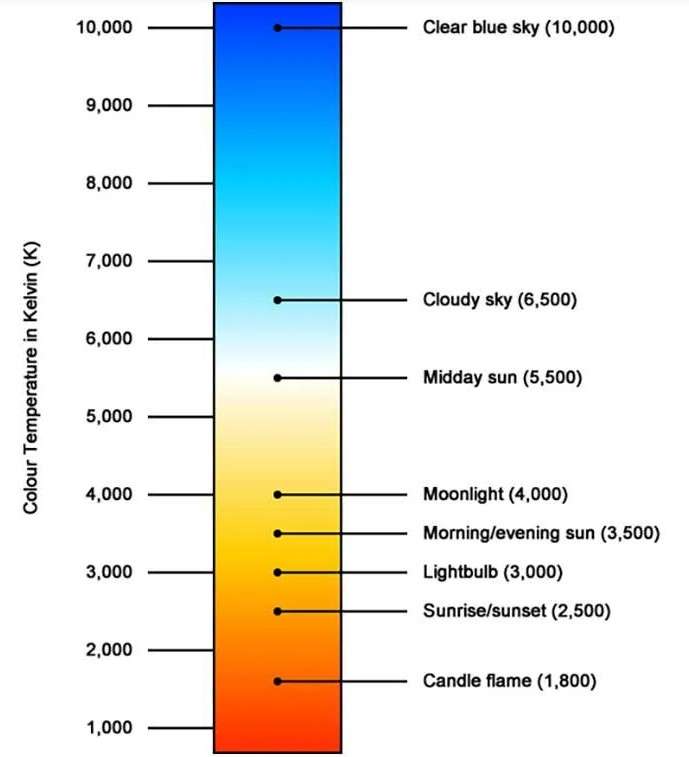
While 5000K LED lighting is often the most versatile and human-friendly option for general use, 6000K lighting offers enhanced clarity and contrast for task-heavy or commercial environments. Your choice should depend on the desired mood, functionality of the space, and personal preference for lighting tone.
Color Temperature in Lighting Applications
Understanding the importance of colour temperature in lighting applications is crucial for achieving the desired atmosphere, improving visual comfort, and ensuring optimal performance in diverse settings. Different colour temperatures evoke distinct emotional responses and have an impact on the functionality of a space. By recognizing the significance of colour temperature, individuals can make informed choices when selecting the appropriate lighting solution for a particular application.
Residential Lighting
In residential settings, the colour temperature plays a significant role in setting the ambience and mood. Warmer colour temperatures (2700K to 3000K) are preferred for living rooms, bedrooms, and dining areas to create a cosy and welcoming atmosphere. Cooler colour temperatures (4000K to 5000K) are more suitable for kitchens, bathrooms, and home offices where tasks require enhanced visibility and concentration.
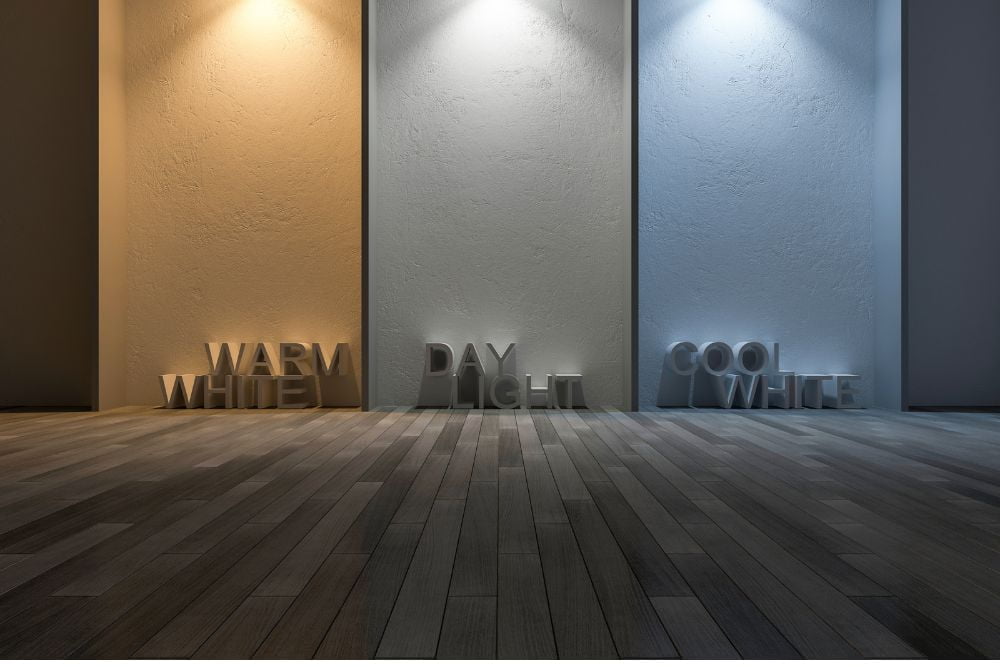
Office and commercial lighting
Neutral to cool colour temperatures ranging from 4000K to 5000K are frequently employed in office spaces, retail stores, and other commercial environments. These colour temperatures enhance alertness, concentration, and productivity while ensuring accurate colour rendition. This is particularly important for reading, writing, or showcasing products.
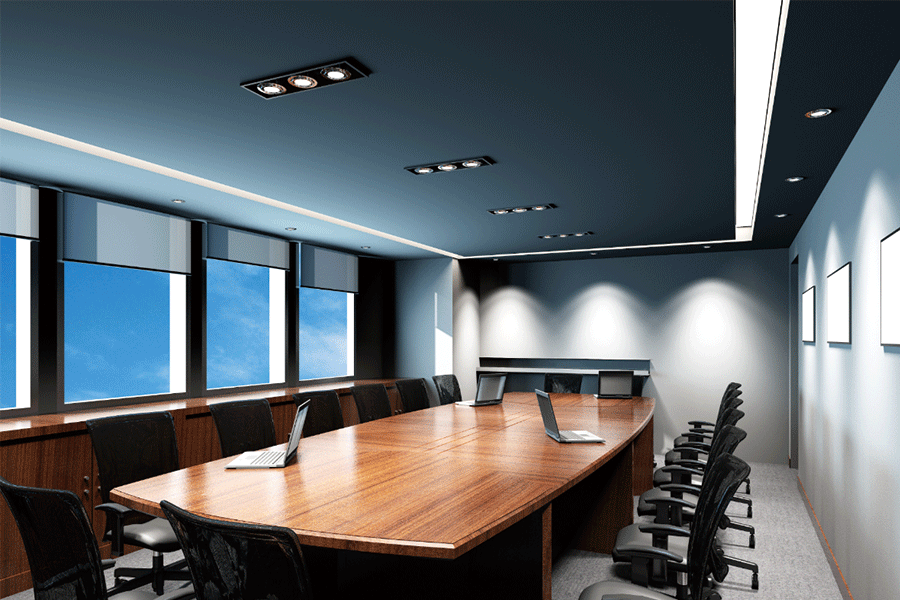
Outdoor and Industrial lighting
Higher colour temperatures (5000K to 6000K and above) are commonly employed for industrial applications, warehouses, parking lots, and outdoor areas. The illumination provided by cool white and blue-white light contributes to improved visibility, safety, and security, thus making it ideal for workspaces and locations requiring high brightness levels.
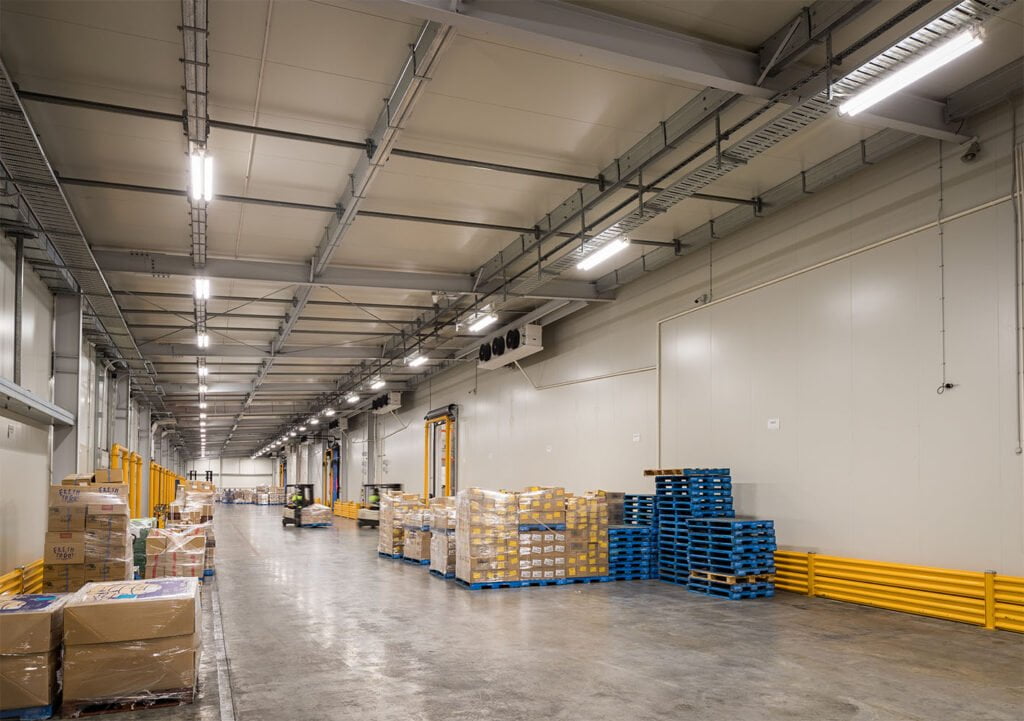
Healthcare and educational establishments
Colour temperature is vital in establishing a comfortable and conducive atmosphere in healthcare and educational facilities such as hospitals, clinics, schools, and universities. Opting for cool white to daylight colour temperatures (4000K to 5000K) is generally preferred as they facilitate concentration, alleviate eye strain, and enhance visibility, thereby promoting productivity.

Museum and Art lighting
When it comes to illuminating art galleries and museums, the choice of colour temperature plays a crucial role in faithfully capturing colours and elevating the visual allure of exhibits. Different colour temperatures, ranging from warm to cool white, are employed based on the specific artwork or display to achieve the desired impact.
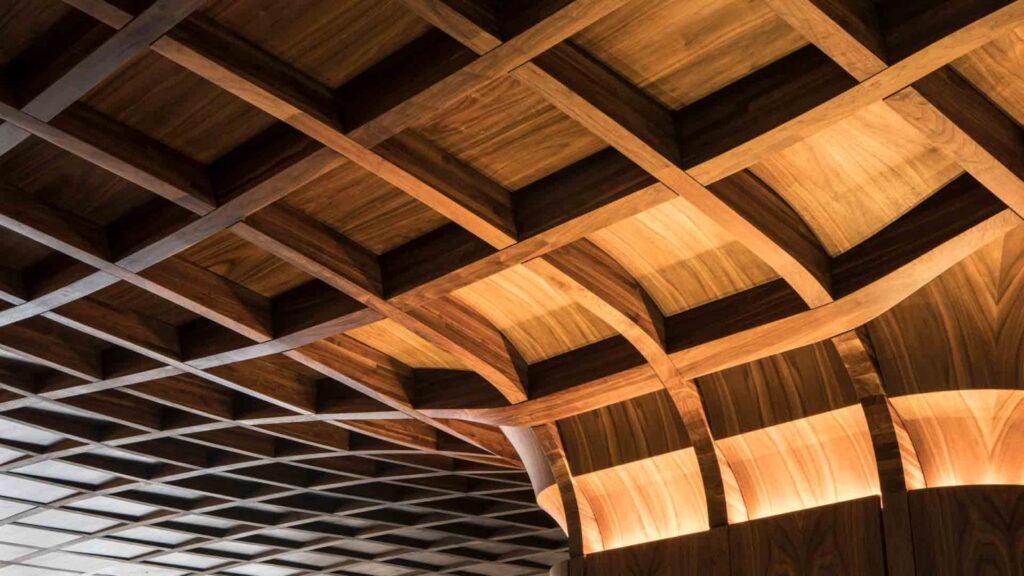
Colour temperature plays a crucial role in lighting applications by establishing the desired ambience, maximizing functionality, and ensuring visual comfort across diverse environments. Carefully selecting an appropriate colour temperature for a particular use can significantly elevate the overall lighting experience and successfully attain the intended result.
What Is the Optimal Color Temperature for Home Lighting?

Choosing the right color temperature for home lighting can dramatically impact the comfort, functionality, and overall mood of your living space. The best choice often depends on the specific purpose of each room, the atmosphere you want to create, and personal preferences. Below is a room-by-room guide to help you select the ideal color temperatures for every area of your home.
Living Room
The living room is a space for relaxing, entertaining, and spending time with family. A warm, inviting light helps create a cozy atmosphere, especially when paired with dimmers that let you adjust brightness for movie nights or quiet evenings.
Recommended color temperature: 2700K–3000K
For added flexibility, consider fixtures with adjustable CCT (2700K–6500K) for different moods.
Bathroom
Bathrooms benefit from clean, bright lighting to support daily routines like grooming, shaving, and applying makeup. A cooler, whiter light enhances visibility and clarity. Installing a dimmer allows you to shift to a softer, spa-like feel when needed.
Recommended color temperature: 4000K–5000K
Bedroom
Bedrooms should promote rest and relaxation. Soft, warm lighting creates a calm environment that’s ideal for winding down at night. Avoid overly bright or cool lighting, which can feel harsh and disrupt your sleep readiness.
Recommended color temperature: 2700K–3000K
Dining Room
Dining areas benefit from a warm and inviting glow that enhances food presentation and creates a pleasant atmosphere. A dimmable fixture lets you fine-tune the lighting to suit casual meals or formal dinners.
Recommended color temperature: 2700K–3000K
Kitchen
Kitchens require bright, functional lighting for cooking, food prep, and reading recipes. A neutral white light strikes the right balance between clarity and comfort. Depending on your kitchen’s decor and adjacent lighting, you might choose slightly warmer or cooler tones.
Recommended color temperature: 4000K–5000K
Conclusion
LED lights with a colour temperature of 6000K emit a cool white light with a subtle blue tint, while lights with a colour temperature of 5000K produce a pure white light. Both options offer similar levels of brightness and energy efficiency. The decision between 6000K and 5000K depends on the desired ambience and functionality of the space.
Understanding the differences between 6000K and 5000K LED lighting can assist you in determining your specific lighting requirements. Consider the colour temperature, brightness, and intended use when selecting the most suitable LED light for your environment.
If you are interested in learning more or have any inquiries, MyLiKeLED is a professional Chinese factory specializing in producing LED strips. Please feel free to contact us, and our team will be ready to assist you in choosing the best LED lighting solution for your needs.
FAQs
5000K is typically better for indoor lighting as it provides a natural white light that closely resembles daylight, offering a balanced and comfortable lighting environment. 6000K can feel too harsh for indoor settings.
For workspaces or offices, 5000K is often preferred because it mimics daylight, which can help increase productivity and reduce eye strain. However, 6000K might be suitable if you need bright, focused lighting.
Neither 6000K nor 5000K inherently provides more brightness. Brightness is determined by the lumens of the light source, not its color temperature. However, 6000K may seem brighter due to its cooler, bluish tone.
Both 6000K and 5000K light bulbs can be energy-efficient, depending on the type of bulb (LED, for example). The energy efficiency doesn’t directly depend on the color temperature but rather the bulb’s technology.
Yes, both 6000K and 5000K are commonly used for outdoor lighting. 6000K offers a bright, cool light that’s good for security lighting, while 5000K gives a natural daylight effect, ideal for general outdoor lighting.

Hi, I’m Xylia Xiong, a sales professional with 14 years of experience in the LED strip light industry. I specialize in providing tailored solutions, leveraging my expertise in LED products and the latest industry trends. Known for effective communication and problem-solving, I’m dedicated to helping lighting manufacturers, importers, and distributors achieve their goals.
Let’s work together to create customized solutions that exceed expectations.
Related Posts

The Best LED Strip Lights You Can Buy Right Now

Comparing WS2811 Vs WS2812B: Key Differences


